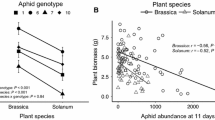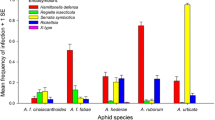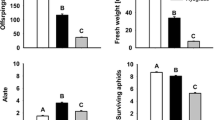Summary
The process of host race formation in the aphid Tetraneura yezoensis is examined in relation to its population structure. T. yezoensis induces pouch galls on new leaves of Ulmus davidiana and U. laciniata. Its populations on the two host species are often sympatric. Fundatrices found on one elm species, when reciprocally transplanted to the other, suffered greatly reduced average fitness. This shows that aphid populations associated with the two elm species are genetically differentiated in physiological traits. Individual trees of each elm species showed large differences in susceptibility to gall formation and in bud burst time, and such between-tree variations were consistent over years. Overwintered eggs taken in early spring from four trees (two from each species) were incubated under the same temperature conditions. The average hatching time differed significantly even between populations from conspecific trees, and the sequence of egg hatching paralleled that of the leafing of those four trees. This between-tree difference in hatching time was consistent over years and was found to be genetic, showing that gene flow between aphid populations on separate trees is often restricted. The heterogeneity in host traits may have promoted the evolution of philopatry in this aphid. Of the fundatrices that hatched on a tree of one elm species, a few precent were preadapted to gall formation on the other elm species. This suggests that the formation of a new host race proceeds parapatrically under disruptive selection and at a low level of gene flow. Evidence was actually obtained that a small fraction of Tetraneura alates are passively transported and land on non-host plants.
Similar content being viewed by others
References
Akimoto S (1988a) Competition and niche relationships among Eriosoma aphids occurring on the Japanese elm. Oecologia 75:44–53
Akimoto S (1988b) The evolution of gall parasitism accompanied by a host shift in the gall aphid, Eriosoma yangi (Homoptera: Aphidoidea). Biol J Linn Soc 35:297–312
Alstad DN, Edmunds GF (1983) Selection, outbreeding depression, and the sex ratio of scale insects. Science 220:93–95
Bale JS (1984) Bud burst and success of the beech weevil, Rynchaenus fagi: feeding and oviposition. Ecol Entomol 9:139–148
Balkau BJ, Feldman MW (1973) Selection for migration modification. Genetics 74:171–174
Baltensweiler W, Benz G, Bovey P, Delucchi V (1977) Dynamics of larch bud moth populations. Ann Rev Entomol 22:79–100
Börner C, Heinze K (1957) Aphidina-Aphidoidea (Sorauer, Handbuch der Pflanzenkrankheiten 5. Bd. Tierische Schädlinge an Nutzpflanzen, 2. Teil, 4. Lieferg). Homoptera II
Bush GL (1974) The mechanism of sympatric host race formation in the true fruit flies (Tephritidae). In: White MJD (ed) Genetic mechanisms of speciation in insects. D Reidel Publishing Company, Dordrecht Boston, pp 3–23
Bush GL (1975) Sympatric speciation in phytophagous parasitic insects. In: Price PW (ed) Evolutionary strategies of parasitic insects and mites. Plenum, New York, pp 187–206
Caisse M, Antonovics J (1978) Evolution in closely adjacent plant populations. IX. Evolution of reproductive isolation in clinal populations. Heredity 40:371–384
Clarke BC, Murray J (1969) Ecological genetics and speciation in land snails of the genus Partula. Biol J Linn Soc 1:31–42
Crawley MJ, Akhteruzzaman M (1988) Individual variation in the phenology of oak trees and its consequences for herbivorous insects. Funct Ecol 2:409–415
Dickinson H, Antonovics J (1973) Theoretical considerations of sympatric divergence. Am Nat 107:256–274
Diehl SR, Bush GL (1984) An evolutionary and applied perspective of insect biotypes. Ann Rev Entomol 29:471–504
Dixon AFG (1976) Timing of egg hatch and viability of the sycamore aphid, Drepanosiphum platanoidis (Schr.), at bud burst of sycamore, Acer pseudoplatanus L. J Anim Ecol 45:593–603
Edmunds GF, Alstad DN (1978) Coevolution in insect herbivores and conifers. Science 199:941–945
Elton CS (1925) The dispersal of insects to Spitzbergen. Trans R Entomol Soc Lond:289–299
Endler JA (1977) Geographic variation, speciation, and clines. Princeton University Press, New Jersey
Felsenstein J (1981) Skepticism towards Santa Rosalia, or why are there so few kinds of animals? Evolution 35:124–138
Frankie GW, Morgan DL (1984) Role of the host plant and parasites in regulating insect herbivore abundance, with an emphasis on gall-inducing insects. In: Price PW, Slobodchikoff CN, Gaud WS (eds) A new ecology. John Wiley & Sons, New York, pp 101–140
Fritz RS, Price PW (1988) Genetic variation among plants and insect community structure: willows and sawflies. Ecology 69:845–856
Fritz RS, Sacchi CF, Price PW (1986) Competition versus host plant phenotype in species composition: willow sawflies. Ecology 67:1608–1618
Futuyma DJ, Mayer GC (1980) Non-allopatric speciation in animals. Syst Zool 29:254–271
Futuyma DJ, Peterson S (1985) Genetic variation in the use of resources by insects. Ann Rev Entomol 30:217–238
Gould F (1983) Genetics of plant-herbivore systems: interactions between applied and basic studies. In: Denno RF, McClure MS (eds) Variable plants and herbivores in natural and managed systems. Academic Press, New York, pp 599–653
Horikawa Y (1976) Atlas of the Japanese Flora, I and II, Gakken, Tokyo
Jaenike J (1981) Criteria for ascertaining the existence of host races. Am Nat 117:830–834
Jain SK, Bradshaw AD (1966) Evolutionary divergence among adjacent plant populations I. The evidence and its theoretical analysis. Heredity 21:407–441
Journet ARP (1980) Intraspecific variation in food plant favourability to phytophagous insects: psyllids on Eucalyptus blakelyi M. Ecol Entomol 5:249–261
Kidd NAC (1985) The role of the host plant in the population dynamics of the large pine aphid, Cinara pinea. Oikos 44:114–122
Koach J, Wool D (1977) Geographic distribution and host specificity of gall-forming aphids (Homoptera, Fordinae) on Pistacia trees in Israel. Marcellia 40:207–216
Komazaki S (1986) The inheritance of egg hatching time of the spirea aphid, Aphis citricola Van der Goot (Homoptera, Aphididae) on the two winter hosts. Kontyu, Tokyo, 54:48–53
McNeilly T (1968) Evolution in closely adjacent plant populations III. Agrostis tenuis on a small copper mine. Heredity 23:99–108
McNeilly T, Antonovics J (1968) Evolution in closely adjacent plant populations IV. Barriers to gene flow. Heredity 23:205–218
Mitter C, Futuyma DJ, Schneider JC, Hare JD (1979) Genetic variation and host plant relations in a parthenogenetic moth. Evolution 33:777–790
Miyawaki A (1988) Vegetation of Japan vol 9, Hokkaido, Shibundo, Tokyo
Moran NA (1981) Intraspecific variability in herbivore performance and host quality: a field study of Uroleucon caligatum (Homoptera: Aphididae) and its Solidago hosts (Asteraceae). Ecol Entomol 6:301–306
Moran NA, Whitham TG (1988) Evolutionary reduction of complex life cycles: loss of host-alternation in Pemphigus (Homoptera: Aphididae). Evolution 42:717–728
Müller FP (1981) Biotype formation and sympatric speciation in aphids. Proceedings of the international aphidological symposium at Jablonna. Polska Akademia Nauk, Instytut Zoologii, pp 135–166
Murray J, Clarke BC (1980) The genus Partula on Moorea: Speciation in progress. Proc R Soc London Ser B 211:83–117
Ng D (1988) A novel level of interactions in plant-insect systems. Nature 344:611–613
Papaj DR, Rausher MD (1987) Components of conspecific host discrimination behavior in the butterfly Battus philenor. Ecology 68:245–253
Rohfritsch O (1988) A resistance response of Picea excelsa to the aphid, Adelges abietis (Homoptera: Aphidoidea). In: Mattson WJ, Levieux J, Benard-Dagan C (eds) Mechanisms of woody plant defenses against insects. Springer, Berlin Heidelberg New York, pp 253–266
Sapporo meteorological observatory (1984) Hakkaido no kisho vol 28
Schneider JC (1980) The role of parthenogenesis and female aptery in microgeographic, ecological adaptation in the fall cankerworm, Alsophila pometaria Harris (Lepidoptera: Geometridae). Ecology 61:1082–1090
Service PM (1984) Genotypic interactions in an aphid-host plant relationship: Uroleucon rudbeckiae and Rudbeckia laciniata. Oecologia 61:271–276
Shields WM (1983) Optimal inbreeding and the evolution of philopatry. In: Swingland IR, Greenwood PJ (eds) The ecology of animal movement. Clarendon Press, Oxford, pp 132–159
Shimura I (1972) Breeding of chestnut varieties resistant to chestnut gall wasp, Dryocosmus kuriphilus Yasumatsu. Jpn Agr Res Q 6:224–230
Slatkin M (1973) Gene flow and selection in a cline. Genetics 75:733–756
Sokal RR, Rohlf FJ (1981) Biometry. Second ed. Freeman and Company, New York
Southwood TRE, Reader PM (1976) Population census data and key factor analysis for the viburnum whitefly, Aleurotrachelus jelinekii (Frauenf.), on three bushes. J Anim Ecol 45:313–325
Strong DR, Lawton JH, Southwood TRE (1984) Insects on plants. Blackwell Scientific Publications, Oxford Edinburgh
Taylor LR, Woiwod IP, Taylor RAJ (1979) The migratory ambit of the hop aphid and its significance in aphid population dynamics. J Anim Ecol 48:955–972
Unruh TR, Luck RF (1987) Deme formation in scale insects: a test with the pinyon needle scale and a review of other evidence. Ecol Entomol 12:439–449
Varley GC, Gradwell GR (1968) Population models for the winter moth. In: Southwood TRE (ed) Insect abundance. (Symposia of the Royal Entomological Society of London No 4). Blackwell Scientific Publications, Oxford Edinburgh, pp 132–142
Wainhouse D, Gate IM, Lonsdale D (1988) Beech resistance to the beech scale: a variety of defenses. In: Mattson WJ, Levieux J, Bernard-Dagan C (eds) Mechanisms of woody plant defenses against insects. Springer, Berlin Heidelberg New York, pp 277–293
White MJD (1978) Modes of speciation. Freeman and Company, San Francisco
Whitham TG (1978) Habitat selection by Pemphigus aphids in response to resource limitation and competition. Ecology 59:1164–1176
Witter JA, Waisanen LA (1978) The effect of differential flushing times among trembling aspen clones on tortricid caterpillar populations. Environ Entomol 7:139–143
Wood TK, Guttman SI (1982) Ecological and behavioral basis for reproductive isolation in the sympatric Enchenopa binotata complex (Homoptera: Membracidae). Evolution 36:233–242
Wool D (1984) Gall-forming aphids. In: Ananthakrishnan TN (ed) Biology of gall insects. Oxford and IBH Publishing, New Delhi, pp 11–58
Author information
Authors and Affiliations
Rights and permissions
About this article
Cite this article
Akimoto, S. Local adaptation and host race formation of a gall-forming aphid in relation to environmental heterogeneity. Oecologia 83, 162–170 (1990). https://doi.org/10.1007/BF00317747
Received:
Accepted:
Issue Date:
DOI: https://doi.org/10.1007/BF00317747




